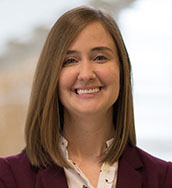Audit effort affected by partner rotation and board inspections, study finds

LAWRENCE — Audit firms and their clients should enjoy a friendly relationship. Just not too friendly.
That’s why the Public Company Accounting Oversight Board (PCAOB) requires such companies to rotate engagement partners every five years.
 But a new study by Amanda Winn, assistant professor of business at the University of Kansas, examines the effects of these regulations on the efforts of auditors. Her article titled “The Joint Effects of Partner Rotation and PCAOB Inspections on Audit Effort” finds that experienced auditors exert reduced effort prior to mandatory partner rotation and increased effort when PCAOB inspection risk is high.
But a new study by Amanda Winn, assistant professor of business at the University of Kansas, examines the effects of these regulations on the efforts of auditors. Her article titled “The Joint Effects of Partner Rotation and PCAOB Inspections on Audit Effort” finds that experienced auditors exert reduced effort prior to mandatory partner rotation and increased effort when PCAOB inspection risk is high.
It appears in Auditing: A Journal of Practice & Theory.
“With partner rotation, they are looking ahead to this process and starting to disinvest their time with the client as their relationship with the client winds up,” Winn said. “Whereas expecting that you will be inspected by the PCAOB has the opposite effect — you ramp up your final effort. As a result, anticipating a PCAOB inspection offsets the effect of mandatory rotation on partners’ final-year effort.”
For an everyday parallel of partner rotation, she compares it to a worker who has decided to switch jobs.
“There are competing arguments as to how you will approach those final few days,” she said.
“It might be, ‘Well, I’m actually going to be working a ton more because I need to get this transition ready and help out the team until I leave.’ Or it might be, ‘I’m unmotivated now, and I’m looking ahead to my next job.’”
Her study suggests potential problems surface during the rotation transition, which could be reduced if the PCAOB inspects those years at higher rates. The board could perceive this as a risk factor that makes it want to select those firms ending engagements for inspection.
Mandatory partner rotation was established when Congress passed the Sarbanes-Oxley Act of 2002. The motivating force behind the regulation was the idea that audit firms and their clients were becoming too entangled, with auditors accused of not being able to form independent assessments about the financial statements.
“Over the years there have been all kinds of proposals to deal with that, including making the whole audit firm switch every so often to keep these long-lasting relationships from forming,” she said.
Exacerbating this problem is some of the most highly visible scandals involving corporations happened when auditors stayed for years or even decades with the same client.
Winn became interested in this topic when interviewing audit partners and Canadian Public Accountability Board members as part of a different project looking into the biggest recent changes to how the audit practice works. She said many auditors felt pressured to provide higher-quality reviews while simultaneously being forced to sever established relationships that made this process more efficient.
To provide richer insights on the effects of these regulations, Winn’s study also drills down on what specific activities auditors plan to change in advance of rotation and inspections.
“I find that both regulations cause auditors to increase time spent on documentation, consistent with auditors’ concerns about the cost of compliance. I find no strong evidence that auditors also increase time spent on other activities, like testing, that can help catch errors and irregularities. In fact, anticipating mandatory rotation causes auditors to spend less time on these testing activities,” she said.
Winn worked as an auditor at KPMG for several years before entering academia and eventually returning to her KU alma mater in 2020 as a professor. Her methodological area of expertise is experimental research: half audit and half financial accounting topics.
She notes how other papers are coming out now that reinforce her “Joint Effects” findings by using proprietary private data about how auditors are altering their behavior to fit with these regulatory motivations.
“I hope my paper sheds some light on the costs and benefits of the regulations overall and provides some more nuance to those other complementary papers,” she said. “It’s important to understand where the effort is being spent and what kinds of behaviors are changing.”
Top photo: Pixabay